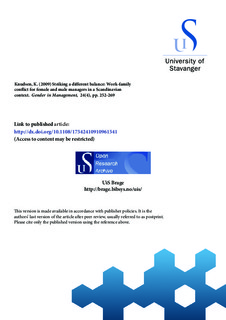| dc.contributor.author | Knudsen, Knud | |
| dc.date.accessioned | 2015-03-05T13:58:25Z | |
| dc.date.available | 2015-03-05T13:58:25Z | |
| dc.date.issued | 2009 | |
| dc.identifier.citation | Knudsen, K. (2009) Striking a different balance: Work-family conflict for female and male managers in a Scandinavian context. Gender in Management, 24(4), pp. 252-269 | nb_NO |
| dc.identifier.uri | http://hdl.handle.net/11250/278528 | |
| dc.description | This article is (c) Emerald Group Publishing and permission has been granted for this version to appear here. Emerald does not grant permission for this article to be further copied/distributed or hosted elsewhere without the express permission from Emerald Group Publishing Limited. | nb_NO |
| dc.description.abstract | Purpose
– The purpose of this paper is to explore how male and female managers may regulate their workload differently in response to conflicting job‐home pressures. The main hypothesis is that female managers seek to reduce anticipated discord by investing less time in their work role. The paper investigates this postulated link between managers' gender and work‐family conflict via their workload, based on a conceptual model and within a Scandinavian context. The central argument is evaluated against a competing explanation of structural constraints, implying that female managers in stead of choosing reduced workloads are required to work less.
Design/methodology/approach
– The paper is based on a large survey of Norwegian managers. The applied sample size is 2,195, with 1,740 men and 455 women. In addition to indicators of time‐based work‐family conflict the questionnaire contains detailed information on managers' individual background and positional characteristics. To trace direct and indirect influences of gender over different analytical stages, a step‐wise regression analysis is carried out.
Findings
– Initial investigations document that female managers have a lighter workload, more frequently perceive glass ceiling constraints and less often experience work‐family conflict. Step‐wise regression analysis demonstrates that the effect of gender on job‐home tensions is mediated mainly by managers' workload, and is less related to the glass ceiling. This pattern is consistent with central hypothesis, still the alternative explanation cannot be totally ruled out.
Research limitations/implications
– This paper is limited to the Scandinavian setting at a single point in time.
Practical implications
– It is important that employers recognize the need for more optimal time arrangements for women in higher‐level positions. In addition, female managers could benefit from support networks across work organizations.
Originality/value
– This paper is among the first to examine the mediational processes by which gender influences work‐family interdependencies for managers, tracing indirect pathways as well as direct effects for alternative model specifications. A representative sample with a broad set of individual and positional characteristics in combination with a relevant regression approach provides credible and robust results. | |
| dc.language.iso | eng | nb_NO |
| dc.publisher | Emerald | nb_NO |
| dc.subject | gender | nb_NO |
| dc.subject | kjønnsroller | nb_NO |
| dc.subject | women executives | nb_NO |
| dc.subject | managers | nb_NO |
| dc.subject | family | nb_NO |
| dc.subject | familie | nb_NO |
| dc.subject | role conflict | nb_NO |
| dc.subject | Norway | nb_NO |
| dc.subject | Norge | nb_NO |
| dc.subject | Skandinavia | nb_NO |
| dc.subject | Scandinavia | nb_NO |
| dc.subject | kvinnelige ledere | nb_NO |
| dc.title | Striking a different balance: work-family conflict for female and male managers in a Scandinavian context | nb_NO |
| dc.type | Journal article | nb_NO |
| dc.type | Peer reviewed | nb_NO |
| dc.subject.nsi | VDP::Social science: 200::Sociology: 220 | nb_NO |
| dc.source.pagenumber | 252-269 | nb_NO |
| dc.source.volume | 24 | nb_NO |
| dc.source.journal | Gender in Management | nb_NO |
| dc.source.issue | 4 | nb_NO |
| dc.identifier.doi | 10.1108/17542410910961541 | |
